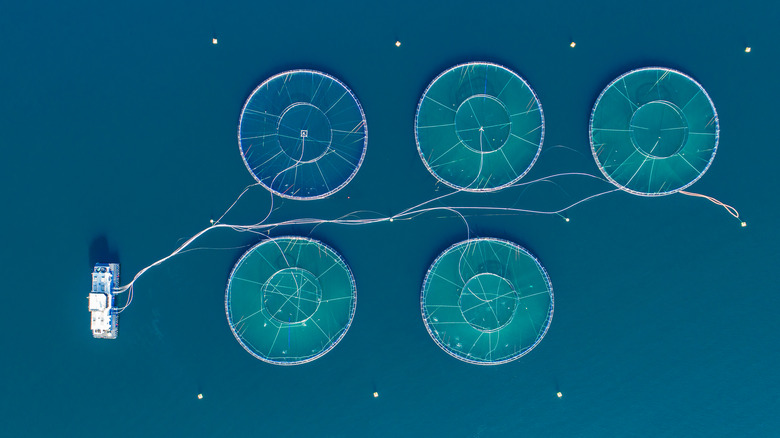Disadvantages In Fish Farming
Fish farming is the practice of captive-raising fish for consumption or other human use. It's also known as aquaculture. Fish farms can be located in freshwater lakes, indoor tanks or saltwater cages in the open ocean. Shellfish such as shrimp are also farmed. Fish farming now accounts for half of all fish consumed worldwide, according to Stanford University. Yet the process has its disadvantages, ranging from disease control to environmental hazards.
Disease
Disease
Keeping fish in close proximity increases the chances of disease. If a fish gets sick with a contagious virus, it's likely to transfer to other fish in the farm. Fish are also vulnerable to infestations of parasites. Farmed salmon in particular are susceptible to outbreaks of sea lice, according to the British Broadcasting System (BBC). In Maine in 2000 an outbreak of anemia in an aquaculture facility led to 2.5 million fish being killed, according to a Time magazine article.
Environment
Environment
Fish farms can have a harmful effect on the local environment. For example, antibiotics and chemicals used to treat fish can leach into surrounding soil and waters, according to the Time magazine article "Is Fish Farming Safe?" This can poison agricultural land. Fish farms can also generate large amounts of effluent, which can harm the immediate location. Diseased fish may escape from the facility, transmitting their condition to wild stocks.
Protein Efficiency
Protein Efficiency
Many farmed fish–such as salmon, bass and cod–are carnivorous. They require large amounts of protein to sustain their fast growth and energy requirements. This protein is often derived from smaller bait fish ground up into pellets. Yet it takes five pounds of fish-meal to create a pound of salmon, according to the Woods Institute for the Environment at Stanford University. This is an inefficient conversion rate. It also means that wild stocks of sardines, mackerel, anchovy and other small fish are targeted, potentially leading to future wild stock crashes.
Set-up Costs
Set-up Costs
Starting up a fish farm can be expensive, particularly in saltwater environments. Fish farmers have to factor in containment areas, such as underwater cages in open seas or large ponds inland. Fish feed, staff, maintenance, disease control, packaging, transport and stocking the facility with fish are all costs associated with aquaculture projects. Fish farming requires more initial investment than some other traditional fishing methods.
Worker Safety
Worker Safety
Worker safety in fish farming depends on individual facilities and national regulations. However, there are risks involved in aquaculture. For example, workers may be exposed to Weil's disease from fish feed and water contaminated by infected rats, according to the UK Health and Safety Executive. Working in isolated locations near water also puts people at risk of accidental drowning.
Cite This Article
MLA
Mitchell, Peter. "Disadvantages In Fish Farming" sciencing.com, https://www.sciencing.com/list-7229120-disadvantages-fish-farming/. 22 November 2019.
APA
Mitchell, Peter. (2019, November 22). Disadvantages In Fish Farming. sciencing.com. Retrieved from https://www.sciencing.com/list-7229120-disadvantages-fish-farming/
Chicago
Mitchell, Peter. Disadvantages In Fish Farming last modified March 24, 2022. https://www.sciencing.com/list-7229120-disadvantages-fish-farming/
